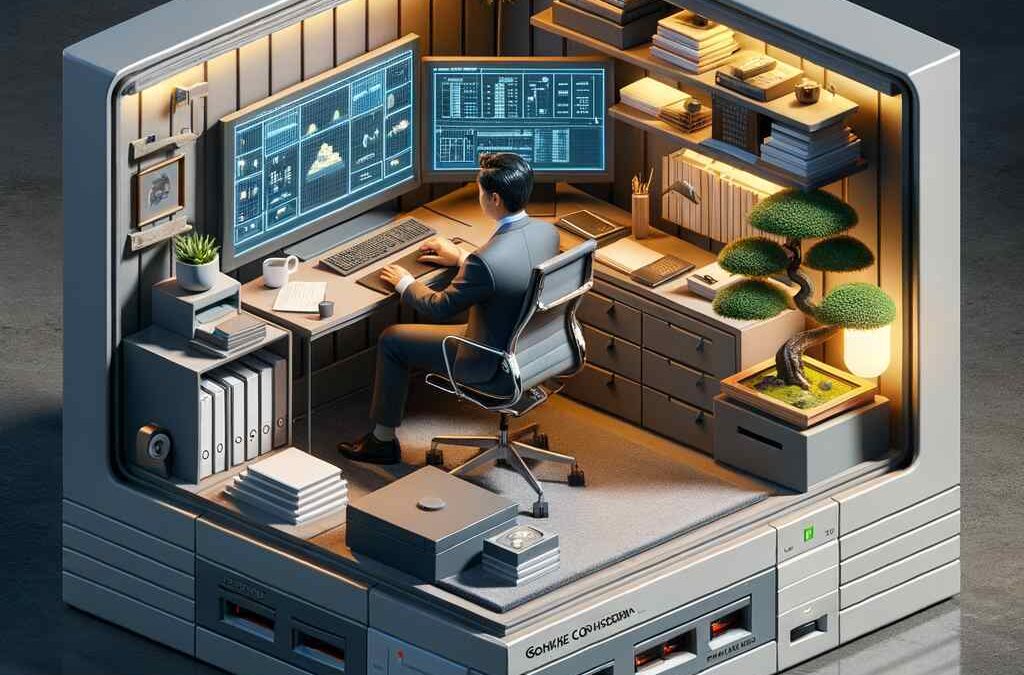
by tyler garrett | Jun 12, 2025 | Data Processing
In today’s fast-paced IT landscape, the prevailing wisdom is clear: if a process is running slowly, simply throwing more processing power at it—meaning more CPUs or cores—is the immediate go-to solution. After all, more cores should mean more simultaneous threads, faster calculations, and quicker job turnaround times, right? Interestingly enough, this intuitive thought process isn’t always correct—for complex data analytics, machine learning pipelines, and high-performance computing scenarios, simply scaling up CPU power may yield diminishing returns, or worse, even poorer performance. Understanding this paradox is critical for technology leaders, data scientists, and software engineers alike effectively driving strategic decisions around system architecture, cloud infrastructure, and optimized analytics workloads.
The Myth of Linear Scalability: A Common Misconception
It seems logical at first glance: double the number of CPU cores available, halve the completion time—yet reality doesn’t always reflect that straightforward arithmetic. The myth of linear scalability lies at the heart of many IT misconceptions. While certain tasks—particularly highly parallelizable workloads—can effectively utilize additional processors, numerous computations are constrained by factors such as sequential processes, thread contention, data dependencies, and resource bottlenecks. In such cases, adding extra cores might minimally impact performance or sometimes worsen it due to overhead introduced by task coordination, synchronization, and computational complexity management.
Consider the case of large-scale automated data analysis tasks like those explained in our article about adversarial robustness in automated data analysis. Such sophisticated analytical workloads often have intricate dependencies where steps must run sequentially, limiting the practical benefits of parallelization. Similarly, extracting meaningful insights through complex visualization tasks can require careful attention to progressive disclosure, a topic we’ve covered in-depth in our guide on complex visualization interfaces. Strategic decision-makers must recognize that multiplying processors won’t always linearly accelerate data-to-insight processes, and prepare for a more nuanced approach.
Bottlenecks Beyond CPU: Identifying Real Performance Constraints
A common pitfall architects and developers encounter when scaling infrastructure revolves around overlooking the actual performance constraint. If CPU scarcity wasn’t a primary bottleneck, adding more CPUs can actually result in negligible benefit. Instead, bottlenecks often emerge from areas such as memory bandwidth, disk I/O latency, inefficient code paths, or inadequate software or data architecture.
In large-scale data platforms, inefficient data handling—like overly complex data structures or poorly managed nested JSON objects—can severely hamper performance regardless of raw CPU power available. Our insights into advanced JSON flattening techniques demonstrate just how critical proper data engineering and structural optimization are in ensuring performance gains. Another key culprit is poor URL management practices; incorrect approaches such as improper split URL column operations, an issue we’ve analyzed in our guide split URL to columns, can quickly overwhelm CPU resources, leading leaders astray to consider more CPUs as a cure rather than addressing underlying structural challenges.
Therefore, decision-makers should rigorously evaluate their infrastructure, performance profiles, code efficiency, and data management strategies before automatically ramping up processing power. An insightful audit by proven experts—like the tailored offerings we’ve laid out in our AWS consulting services—can quickly pinpoint actual performance obstacles and propose genuinely effective remediation strategies, including targeted attacks on data inefficiencies and software complexity, rather than blind hardware expansion.
Multithreading Complexity: When Concurrency Slows You Down
This paradox intensifies further when we introduce intricacies around concurrent programming. Multithreading allows workloads to efficiently divide themselves across CPUs, theoretically boosting performance. However, as complexity grows, threads may suffer from contention on shared resources, synchronization overhead, and diminishing thread throughput. With more cores working simultaneously, threads frequently get stuck waiting for access to common data stores, queues, buffers, or shared caches. In extreme scenarios, increasing concurrent tasks can dramatically slow down a process instead of accelerating it, inadvertently damaging the overall throughput and responsiveness.
As highlighted in our exploration of innovative architectural patterns like our discussion of hexagonal architecture for data platforms, software architecture significantly impacts scalability. Thoughtfully applying patterns like Ports and Adapters can substantially reduce concurrency complications by clearly separating concerns and minimizing thread conflicts. Decision-makers interested in achieving peak performance and system responsiveness must embrace modern approaches to software architecture beyond just hardware-oriented ones.
The CPU Usage Fallacy: High Utilization Doesn’t Equal Optimal Performance
Many organizations focus too narrowly on increasing CPU utilization as an indicator of productivity and efficiency, misunderstanding a fundamental aspect of performance scaling: utilizing CPU resources to 100% capacity doesn’t necessarily indicate optimal job performance or system efficiency. High CPU usage often can translate into resource-hungry tasks or inefficiencies within processes themselves. Rather than a sign of well-executed optimization, sustained spikes in CPU usage are often symptomatic of underlying computational inefficiencies, overhead burdens from parallelization, or poorly designed workflows unable to effectively leverage parallel substrates.
Supporting a data-driven approach towards optimization, such as the one we’ve detailed in our article on adopting a modern software consultancy mindset, enables strategic architects and developers to move beyond surface-level CPU utilization metrics. Contextualizing resource usage across other measurable dimensions—like workflow throughput, latency reductions, time-to-insight acceleration, and accuracy enhancements—provides far greater insight into genuine performance improvements beyond simple processor utilization charts.
Conflicting Priorities: Security, Privacy, and Processing Power
Beyond purely technical considerations, competing factors like security and data privacy directly influence performance optimization strategies. Implementing advanced data sensitivity classifications and privacy protections for regulatory compliance—as we illustrate in our exploration of automated data sensitivity classification using Machine Learning and our insights on effective consent management systems—comes with necessary overhead costs. Such essential security and privacy operations inherently introduce computational overhead, limiting the scalability benefit that increased CPU cores alone could provide.
Organizations must clearly balance their strategic priorities—performance optimization initiatives with essential security protection—and deeply understand that effective processing performance comes from more nuanced solutions than just raw hardware power enhancement. For enterprises navigating the intersectionality between performance, privacy, and regulatory demands, consulting with strategic technology advisors can help frame these trade-offs more transparently, ensuring more robust, secure, and efficient system deployments.
Optimal Scalability Demands Holistic Technical Strategy
To effectively address the core paradox of CPUs—recognizing why more processors don’t always equal faster jobs—modern decision-makers must adopt a comprehensive, nuanced, and strategic approach. Improving computational performance and system scalability requires going beyond simple hardware expansion; it demands thoughtful alignment of data engineering practices, targeted architecture innovations, deep analysis of real performance bottlenecks, strategic cloud solutions leveraging services like our AWS consulting services, and balancing security and data privacy obligations.
The challenge decision-makers face isn’t merely technological—it’s fundamentally strategic. Organizations recognizing and acting upon these insights can harness evolving technological strategies to power meaningful performance gains beyond mere CPU counts. Only through adopting a holistic, informed approach can leaders move beyond pervasive myths surrounding computational and concurrency optimization, empowering their organizations to leverage CPUs effectively within comprehensive and strategically robust technological solutions.

by tyler garrett | Jun 12, 2025 | Data Processing
In the dynamic landscape of data analytics, seasonality is an undeniable force shaping your strategic decisions. Businesses confronting cyclical data variations—whether daily, monthly, or annual trends—must adapt algorithms intelligently to uncover impactful insights and predict outcomes with greater accuracy. With the volume of available information continually expanding, leveraging cyclical patterns through refined algorithmic techniques isn’t just good practice; it’s a strategic imperative. Join us as we explore how savvy leaders adapt algorithms to effectively navigate and leverage seasonality effects, driving innovation, precision, and competitive advantage.
Understanding Seasonality in Data Analysis
Seasonality refers to recurring variations in data that occur regularly over certain intervals, driven often by outside influences such as time of day, week of the year, or broadly accepted patterns tied to economic, social, or environmental cycles. Businesses encounter cyclical data frequently—for instance, retail sales peak during holiday seasons, and electricity usage usually follows daily patterns.
These cyclic patterns complicate predictive analytics since traditional data models may fail to account for repeating variations, leading to less-than-optimal outcomes. The key to managing seasonality effectively relies on first thoroughly understanding its roots and manifestations in your data. Whether the context is financial forecasting, resource optimization, or market demand predictions, correctly recognizing and modeling these patterns is crucial.
By strategically deploying analytics and adapting algorithms to better capture trends, organizations can achieve enhanced clarity that drives better strategic decisions. For instance, leveraging advanced cloud-based infrastructures like those available through our tailored AWS consulting services, businesses can robustly scale models to handle vast datasets and uncover hidden seasonal patterns that contribute directly to their bottom line.
Common Challenges in Seasonality Detection and Mitigation
Despite an intuitive appeal, detecting and accommodating seasonal variations pose familiar yet complex challenges. A common difficulty is distinguishing between genuine cyclical variations versus random fluctuations or short-term anomalies. Misidentification can lead not just to inaccuracies, but could potentially skew entire business strategies and revenue projections.
Another significant hurdle involves handling incomplete or inconsistent datasets—a reality faced by virtually every enterprise. Issues of missing data or dark data—the significant category of information collected but often unused—further complicate cyclical management. Organizations often overlook this powerful asset due to limited visibility, hindering their full analytical potential. Fortunately, strategic approaches to analytics like dark data discovery empower businesses to illuminate unused, hidden information effectively. Coupled with an appropriate governance framework such as our recommended inter-company data sharing governance framework, companies achieve greater data transparency and clarity, enabling superior cyclical pattern recognition.
Additionally, traditional analytical frameworks may prove inadequate when attempts are made to manage seasonality; many models do not inherently account for cyclical factors, requiring explicit adjustment or enhancement via data engineering, algorithms tailored for specific applications, or advanced forecasting techniques.
Algorithmic Strategies for Seasonal Adjustments
The journey towards accurately accommodating cyclicality in data begins by adopting robust algorithmic strategies capable of overcoming these challenges. One approach often utilized by data scientists involves decomposition methods–breaking time series data into trend, seasonal, and residual (also known as random or irregular) components. Models such as Seasonal ARIMA (SARIMA), Holt-Winters exponential smoothing, Prophet forecasting, or machine learning models optimized specifically for cyclic patterns greatly enhance forecasting precision.
Adapting standard predictive models to specific contexts calls for careful decisions about transformations like detrending or deseasonalizing the data before input into predictive frameworks. Strategies such as feature engineering, Fourier transforms for periodicity, or external trend regressors sharpen the model’s performance and inform practical decision-making. Importantly, businesses often incorporate newer next-generation techniques that enable them to deeply embed an understanding of seasonality within their data pipelines. For instance, the effective integration and optimization of tools illustrated in this discussion on Embracing Node.js for Data Engineering demonstrates how robust machine learning integration capabilities enable highly adaptable algorithmic solutions to emerging cyclical insights.
Visualizing Seasonality – The Catalyst for Data-Driven Decisions
Visualization transforms abstract cyclicality into intuitive business narrative. Harnessing cutting-edge visualization toolsets enables real-time interpretation of seasonal data for clearer strategic decision-making. Visualization tools like Tableau empower decision-makers—especially with innovations like the Colibri Google Analytics Tableau Dashboard, which contextualizes seasonal web traffic—heightening your organization’s capability to comprehend complex cyclical information rapidly.
Effective visualization hinges on more than aesthetics—it relies heavily on consideration of color harmony principles. Applying disciplined approaches to color choices, as outlined in our framework on color harmony theory applied to data visualization palettes, enables faster comprehension of intricate seasonal trends, allowing stakeholders to detect seasonality nuances more intuitively and make quicker, informed decisions.
Visual storytelling around cyclical data simplifies critical insights and mitigates misunderstanding. Beyond analysts and engineers, intuitive seasonal visuals help non-technical stakeholders gain greater data literacy, unlocking enterprise-wide potential for better-aligned strategic and operational actions.
Integrating Ethics and Sustainability in Seasonal Algorithm Design
Developing seasonal algorithms opens opportunities to reinforce ethically responsible data practices and sustainable analytics cultures. Ensuring transparency in algorithmic models and maintaining responsible data governance frameworks become essential responsibilities. Actively ensuring ethical data collection and analytical processes—which you can explore further in our recommended article detailing five software engineering ideas to enhance ethical data collection and analysis practices—can effectively mitigate inherent biases that seasonal adjustments might mistakenly amplify.
A company’s commitment to sustainability and ethical practices also significantly influences consumer perception. Companies embracing ethical data engineering and careful seasonality analysis set themselves apart as responsible industry thought-leaders, fostering the confidence of stakeholders, customers, and the marketplace. Organizations that incorporate foundational principles of transparency, fairness, and accountability consistently derive more value from analytics investments, strengthening performance and bottom-line results while enhancing brand reputation.
As your company’s cyclical analytical capabilities mature, embedding deliberate ethical frameworks serves to protect your organization’s integrity, reputation, compliance posture, and long-term value guarantee.
Empowering Strategic Decisions Through Adapted Algorithms
Successfully adapting algorithms for seasonality involves carefully balancing technical integrity with strategic value extraction. The most successful organizations confront cyclical data not as a challenge, but rather as a strategic opportunity to lead by innovation. Achieving this balance demands data literacy uplift across your organization, strategic alignment between technical solution-building and strategic imperative, and thoughtful application of visually intuitive analytics techniques.
By applying seasonality-informed analytical innovations and visualization strategies, leaders transform traditional data challenges into clear-cut strategic assets. Deploying customized consulting solutions like those offered through Dev3lop’s AWS consulting services further ensures scalability, performance, and agility in your analytics strategy, enabling your business to make decisive, evidence-driven business strategizing.
Ultimately, organizations capitalizing effectively on cyclical data insights position themselves significantly ahead of competitors, equipped to launch confident strategies calibrated finely to seasonal cycles, and securely anchored in responsible, ethical analytics practice.
Conclusion – Confidently Navigate Seasonality in Data Analytics
Effectively navigating cyclical patterns is more than algorithmic necessity; it’s a critical differentiator for modern, data-driven enterprises. Embrace these capabilities by comprehensively understanding cyclical effects, applying strategic algorithmic adjustment methods, utilizing intuitive visualization techniques, and ensuring ethically grounded, sustainable frameworks.
Ready to explore seasonal data analytics-driven strategies further? Connect with our experts today and empower your organization to confidently leverage insights embedded within cyclical rhythms, fostering smarter choices, operational efficiency, and competitive differentiation.

by tyler garrett | Jun 12, 2025 | Data Processing
In the digital age, data is the lifeblood flowing through the veins of every forward-thinking organization. But just like the power plant supplying your city’s electricity, not every asset needs to be available instantly at peak performance. Using temperature tiers to classify your data assets into hot, warm, and cold storage helps businesses strike the right balance between performance and cost-effectiveness. Imagine a data strategy that maximizes efficiency by aligning storage analytics, data warehousing, and infrastructure costs with actual usage. It’s time to dive into the strategic data temperature framework, where a smart approach ensures performance, scalability, and your organization’s continued innovation.
What Are Data Temperature Tiers, and Why Do They Matter?
The concept of data temperature addresses how frequently and urgently your business accesses certain information. Categorizing data into hot, warm, and cold tiers helps prioritize your resources strategically. Think of hot data as the data you need at your fingertips—real-time actions, analytics dashboards, operational decision-making data streams, and frequently accessed customer insights. Warm data includes information you’ll regularly reference but not continuously—think monthly sales reports or quarterly performance analyses. Cold data applies to the archives, backups, and regulatory files that see infrequent access yet remain critical.
Understanding the nuances and characteristics of each temperature tier can significantly reduce your organization’s data warehousing costs and improve analytical performance. Adopting the right storage tier methodologies ensures rapid insights when you require immediacy, along with scalable economy for less frequently accessed but still valuable data. Charting a smart data tiering strategy supports the dynamic alignment of IT and business initiatives, laying the foundation to drive business growth through advanced analytics and strategic insights.
Navigating Hot Storage: Fast, Responsive, and Business-Critical
Characteristics and Use Cases for Hot Data Storage
Hot storage is built around the idea of instant access—it’s real-time sensitive, responsive, and always reliable. It typically involves the data you need instantly at hand, such as real-time transaction processing, live dashboards, or operational fleet monitoring systems. Leading systems like in-memory databases or solid-state drive (SSD)-powered storage solutions fit this category. Hot storage should be prioritized for datasets crucial to your immediate decision-making and operational procedures—performance here is paramount.
Key Considerations When Implementing Hot Data Tier
When developing a hot storage strategy, consider the immediacy and cost relationship carefully. High-performance solutions are relatively more expensive, thus requiring strategic allocation. Ask yourself these questions: Does this dataset need instant retrieval? Do I have customer-facing analytics platforms benefitting directly from instant data access? Properly structured hot-tier data empowers stakeholders to make split-second informed decisions, minimizing latency and improving the end-user experience. For instance, effectively categorized hot storage drives measurable success in tasks like mastering demand forecasting through predictive analytics, significantly boosting supply chain efficiency.
The Warm Tier: Finding the Sweet Spot Between Performance and Cost
Identifying Warm Data and Its Ideal Storage Scenarios
Warm storage serves data accessed regularly, just not immediately or constantly. This often covers reports, historical financials, seasonal analytics, and medium-priority workloads. Organizations frequently leverage cloud-based object storage solutions, data lakes, and cost-efficient network-attached storage (NAS)-style solutions for the warm tier. Such data assets do require reasonable responsiveness and accessibility, yet aren’t mission-critical on a second-to-second basis. A tailored warm storage strategy provides accessible information without unnecessarily inflating costs.
Implementing Effective Warm Data Management Practices
Effective organization and strategic placement of warm data within your data lake or data fabric can boost analytical agility and responsiveness when tapping into past trends and reports. Employing data fabric visualization strategies enables intuitive stitching of hybrid workloads, making it effortless for stakeholders to derive insights efficiently. The warm data tier is ideal for analytics platforms performing periodic assessments rather than real-time analyses. By properly managing this tier, organizations can significantly decrease storage expenditure without sacrificing essential responsiveness—leading directly toward optimized business agility and balanced cost-performance alignment.
Entering the Cold Data Frontier: Long-Term Archiving and Reliability
The Importance of Cold Data for Regulatory and Historical Purposes
Cold storage comprises data that you rarely access but must retain for regulatory compliance, historical analysis, backup recovery, or legacy system migration. Relevant examples include compliance archives, historical financial records, infrequent audit trails, and logs no longer frequently reviewed. Solutions for this tier range from lower-cost cloud archive storage to offline tape solutions offering maximum economy. Strategically placing historical information in cold storage significantly reduces unnecessary costs, allowing funds to be shifted toward higher-performing platforms.
Successful Strategies for Managing Cold Storage
Effectively managing cold storage involves clearly defining retention policies, backup protocols, and data lifecycle practices such as backfill strategies for historical data processing. Automation here is key—leveraging metadata and tagging makes cold data discoverable and streamlined for infrequent retrieval tasks. Consider adopting metadata-driven access control implementations to manage data securely within cold tiers, ensuring regulatory compliance and sustained data governance excellence. Smart cold-tier management doesn’t just protect historical data; it builds a robust analytical foundation for long-term operational efficiency.
Integrating Temperature Tiers into a Cohesive Data Strategy
Constructing an Adaptive Analytics Infrastructure
Your organization’s success hinges upon leveraging data strategically—and temperature tiering provides this capability. Smart organizations go beyond merely assigning data into storage buckets—they actively integrate hot, warm, and cold categories into a unified data warehousing strategy. With careful integration, these tiers support seamless transitions across analytics platforms, offering intuitive scalability and improved reliability. For example, quick-loading hot data optimizes interactive analytics dashboards using tools like Tableau Desktop. You can easily learn more about installing this essential tool effectively in our guide on installing Tableau Desktop.
Optimizing Total Cost of Ownership (TCO) with Tiered Strategy
An intelligent combination of tiered storage minimizes overall spend while maintaining outstanding analytics capabilities. Deciding intelligently regarding data storage temperatures inherently optimizes the Total Cost of Ownership (TCO). Holistic tiered data integration enhances organizational agility and drives strategic financial impact—direct benefits include optimized resource allocation, improved IT efficiency, and accelerated innovation speed. Our team at Dev3lop specializes in providing tailored data warehousing consulting services, positioning our clients ahead of the curve by successfully adopting temperature-tiered data strategies.
Begin Your Journey with Expert Insights and Strategic Support
Choosing the optimal data storage temperature tier demands strategic foresight, smart technical architecture, and a custom-tailored understanding to maximize business value. Whether you are performing real-time analytics, seasonal performance reviews, or working toward comprehensive regulatory compliance, precise data tiering transforms inefficiencies into innovation breakthroughs. Our expert technical strategists at Dev3lop offer specialized hourly consulting support to help your team navigate storage decisions and implementation seamlessly. Make the most of your infrastructure budget and explore opportunities for strategic efficiency. Learn right-sizing analytics, platforms optimization, and more, leveraging analytics insights to grow your capabilities with our blog: “10 Effective Strategies to Boost Sales and Drive Revenue Growth“.
Your journey toward strategic hot, warm, and cold data management begins today—let’s innovate and accelerate together.

by tyler garrett | Jun 12, 2025 | Data Processing
If you’ve ever ventured into the realm of hierarchical data, you’ve surely encountered the bittersweet reality of recursive relationships—those intricate, repeating patterns embedded within trees, graphs, and nested structures that both fascinate and frustrate data architects alike. These recursive nightmares aren’t mere inconveniences; they’re core challenges that influence performance, scalability, and the accuracy of analytics workloads. At Dev3lop, we spend considerable time untangling complexities in hierarchical data structures, turning data-driven dilemmas into clear, actionable insights for businesses. Join us on a journey to demystify these recursive structures, understand their implications, and leverage them expertly to enhance your data strategies.
The Recursive Backbone: Decoding Trees and Graph Structures
Hierarchical data isn’t just common across industries—it’s foundational. Organizational charts, product categories, biological taxonomies, and social networks depend on tree and graph structures. These data models excel in depicting relationships between entities because of their inherently recursive nature, where a parent-child or graph node-edge relationship can indefinitely repeat itself, giving rise to deeply nested hierarchies.
But recursion, while powerful in depicting real-world relationships, can lead to nightmares in unskilled hands. For example, when traversing deeply nested tree structures, you risk performance bottlenecks and inefficient queries. If your data workflow isn’t optimized for recursion, you can quickly degrade from milliseconds to several agonizing seconds or even minutes, depending on the depth and complexity of your hierarchical data.
It’s essential to remember that clear representation isn’t the end goal—it’s the start. You want to ensure that your queries, transformations, and visualizations can handle hierarchical data efficiently. Specific visualization techniques, like those outlined in our guide on horizon charts for dense time-series visualization, illustrate the strategic advantage of selecting appropriate visualization methods to articulate intricate patterns clearly and effectively.
The Complexity Conundrum: Performance and Recursive Data Queries
Recursive structures often imply complex queries, which can strain databases and analytical tools not optimized for these data types. This is because recursive queries typically require the system to traverse hierarchical relationships repeatedly, as they dynamically explore potentially unknown levels of depth. Without careful planning and engineering, such recursion could overwhelm conventional relational database engines, resulting in slow performance and degraded user experiences.
This complexity becomes glaringly apparent with recursive Common Table Expressions (CTEs), a powerful SQL construct used widely to traverse hierarchical data. While recursive CTEs simplify query logic, they can negatively impact performance if not properly structured. Ensuring resilient database management involves applying methods from our expertise in resilient pipeline design with graceful degradation. Incorporating these principles into your data engineering strategy mitigates risks of slow-running, resource-heavy queries, allowing queries to gracefully self-manage when encountering unbounded recursion.
The secret sauce? Carefully indexing hierarchical fields, limiting recursion depths, and judicious data filtering. When approached correctly, recursive querying can shift from being a cumbersome bottleneck to an efficient and elegant technique, seamlessly supporting the business-critical analytics and operations you depend on daily.
Visualization Challenges: Clarity Amid Complexity
Visualizing hierarchical structures is paramount for informed decision-making, but recursive data often muddies visualization attempts. Each additional recursion layer exponentially increases the complexity of visual presentations, creating difficulties for clarity, readability, and communication. Too easily, critical relationships become obscured within overly dense and tangled visualizations, diluting valuable insights that hierarchical data is meant to convey.
At Dev3lop, we recommend utilizing specialized techniques, such as the approaches discussed in quaternion-based visualizations for higher-dimensional data, to simplify complex visual structures effectively. Techniques such as sunburst diagrams, dendrograms, or treemaps can efficiently represent hierarchical information, provided the data visualization method aligns closely with your strategic intent.
Additionally, borrowing from our extensive experience with narrative visualization techniques for data storytelling, hierarchical visuals can be integrated seamlessly into interactive narratives. Dynamic filtering and exploration capabilities, for example, empower stakeholders to manage complexities independently, navigating through recursive structures intuitively to illuminate meaningful outcomes. Ensuring thoughtful visual strategies not only promotes easy comprehension but generates actionable business insights grounded in clear understanding.
AI and Machine Learning: Tackling Hierarchical Complexity at Scale
As data volumes continue to grow exponentially, recursive structures steadily become more complicated, making manual navigation and interpretation practically impossible. Artificial Intelligence and Machine Learning emerge as powerful allies here, capable of understanding and extracting meaning from recursive hierarchical datasets more effectively than traditional methods.
Our exploration into core principles of AI agents and machine learning pipeline design for production highlights how advanced analytical strategies help manage recursion and uncover hidden relationships at scale. Algorithms designed specifically for hierarchical data, including decision tree models, graph neural networks (GNNs), and recursive neural networks (RvNNs), offer groundbreaking possibilities for parsing and interpreting complexity.
With the support of well-crafted machine learning pipelines, businesses can analyze, visualize, and make decisions efficiently—transforming recursive nightmares into strategic assets. Effective AI and ML incorporation ensures your hierarchical analyses remain robust, sustainable, and nimble as the complexity of your data evolves.
Practical Recommendations: Implementing Recursive Data Solutions
Mitigating risks in trees, graphs, and other hierarchical data models involves decisions about tooling, design, and performance optimization. Start by clearly defining the depth, breadth, and usage patterns of your hierarchical data, then select appropriate data structures to support your strategic objectives efficiently.
Structured design guidelines informed by seasoned insights, such as those covered in market trend analysis and demand forecasting, combined with performance-tuned indexing and thoughtful caching of hierarchical information, form a robust foundation for scalable recursive strategy. Alongside your data engineering solutions, prioritize a strategic adherence to contemporary data privacy regulations impacting analytics, thus ensuring compliance, reliability, and trustworthiness of your recursive workflows.
Furthermore, leverage advanced visualization approaches proven to excel in specific data structures, like ternary plots for compositional data, to enhance clarity. A carefully chosen visualization ensures straightforward interpretation, driving data-driven decisions grounded in comprehensive understanding, clarity, and predictability.
Strategic Partnership: Unlock Recursive Data Potential
Hierarchical data structures, despite their complexities and recursion-induced nightmares, contain significant potential when expertly harnessed. However, tackling recursion issues in isolation can place undue strain on internal teams, potentially resulting in missed opportunities or expensive missteps. Partnering strategically with experienced specialists such as Dev3lop’s Data Engineering Consulting Services in Austin, Texas can reduce the challenges associated with recursive data structures efficiently.
As seasoned data strategists, our mission is identifying, mitigating, and refining hierarchical tree and graph complexities in alignment with your organizational goals. By strategically optimizing infrastructure, visualizations, and analytical models, we transform recursive data from a source of anxiety into competitive advantage, fueling informed, swiftly derived insights that lead to smarter decisions and ongoing success in the data-driven transformative landscape.
Ready to overcome the nightmares of recursive workloads? Partnering with our consulting expertise elevates your ability to transform complexity into clarity.

by tyler garrett | Jun 12, 2025 | Data Processing
In today’s data-driven landscape, the volume and variety of unstructured information flowing daily into organizations can quickly become overwhelming. With business leaders and technologists recognizing the immense potential hidden in unstructured data—such as images, documents, logs, and complex JSON blobs—the question arises: how do you efficiently extract meaningful insights and actionable schemas? Breaking through the metadata maze isn’t simply an operational task—it’s strategic. Whether you’re working with customer feedback, event logs, or unstructured streams from IoT devices, uncovering the schemas and relationships embedded within raw data leads to clearer decision-making. Leveraging techniques to systematically extract metadata is essential for enterprises intent on staying ahead of competitors. Let’s delve deeper into how organizations navigate this complex maze effectively and the best strategic approaches to transform raw data chaos into valuable insights.
Understanding the Challenge of Unstructured Data
Unstructured data now represents the majority of data being collected by organizations, encompassing everything from textual documents, audio files, images, JSON blobs, IoT logs, to user-generated content and social media interactions. Unlike typical structured data managed within relational databases where schemas are predefined, unstructured data by definition lacks clear boundaries and structured schemas. Its free-form nature means traditional analytical processes struggle to make sense of it. This scenario calls for strategic methods and innovative approaches to extract valuable knowledge efficiently.
Traditionally, structured data could be easily queried using powerful SQL logical operators, allowing business analysts to perform quick, targeted analytics. Unstructured data, on the other hand, requires extensive pre-processing, parsing, and even machine learning-powered algorithms to transform into a structured format or schema-friendly state for meaningful consumption. The resulting inefficiencies or inaccuracies in managing unstructured data negatively impact insights, resulting in misguided decisions or costly rework.
Understanding this challenge means appreciating how businesses ultimately want usable insights quickly yet are confronted by an ever-growing stream of messy, poorly organized data bits that obscure opportunities. It’s within this metadata maze—the complexity buried just below the surface—where leading companies differentiate themselves, rapidly deciphering meaningful signals hidden within chaos. Only when organizations understand clearly the nuances of handling such varied, unpredictable data types can they align their data strategy with critical business objectives effectively.
The Strategic Value of Schema Extraction from Unstructured Blobs
Extracting schemas and metadata from unstructured blobs goes beyond operational technicality; it can significantly impact strategic business value, fostering actionable analytics and enhanced decision-making. Organizations that successfully leverage these hidden schemas accelerate insights, improve forecasting accuracy, and proactively react to market trends and customer preferences. Consider schema extraction as a process that effectively transforms opaque data blobs into actionable structures—revealing hidden semantic relationships, taxonomy elements, and attributes valuable for technical stakeholders and business strategists alike.
An effective schema extraction strategy empowers decision-makers to understand not only what data is collected but also its true structure, lineage, and meaning—revealing the “golden record” hidden in multi-source systems, something organizations address through robust golden record management. As metadata extraction simplifies data integration tasks, enterprises can synchronize analysis across departmental silos more effectively. Leveraging schema discovery allows analysts to build powerful visualizations and stories from initially ambiguous information sets, proactively avoiding common pitfalls described in our article on avoiding dashboard strategy failures.
Furthermore, schema extraction methodologies directly support operational efficiencies, as data architects better optimize data warehousing schema conformity and dimensional management. This capability shortens the path from raw data to intended business insights and ensures consistency, quality, and timeliness. By strategically converting unstructured blobs into clear, reusable schemas, decision-makers can confidently leverage investments into platforms like Power BI with confidence (check our strategic Power BI consulting services), transforming raw data into business decision-ready visualizations and metrics efficiently.
Practical Methodologies: Navigating the Metadata Maze
Effectively navigating the maze of metadata extraction requires a thoughtful blend of methodologies and frameworks tailored specifically to the organization’s needs and business contexts. Strategic best practices often combine automated discovery using sophisticated machine learning algorithms, data mining approaches, domain-driven design principles, and well-defined architectural patterns, such as Hexagonal Architecture and its Ports and Adapters approach. More advanced strategies even align closely with data platform design principles, leveraging domain-driven data design and bounded contexts to clarify data usage and schema responsibilities.
Automating metadata discovery through natural language processing, classifiers, and clustering algorithms speeds up insights generation dramatically. New sessions drawn from enterprise data model versioning principles ensure extracted schemas adapt flexibly and reliably over time. Simultaneously, manual oversight through domain subject matter experts (SMEs) ensures automation does not veer toward inaccuracies by anchoring insight extraction methodologies firmly within business relevance.
On a practical level, beginning the schema extraction process usually starts by establishing data governance rules, selecting industry-standard taxonomies, and carefully managing data model evolution and versioning practices. Adequate automation complemented with human validation assures optimal schema mapping—transforming unstructured data chaos into precise, actionable insights enabling effective analytics.
Best Practices for Schema-Driven Insights From Unstructured Blobs
When establishing a best practices framework, consider a thorough approach encompassing automation, collaboration, governance, and scalability. Begin by clearly defining business-oriented objectives around unstructured data use. Next, consistently align schema extraction routines to strategic goals, avoiding ad-hoc processes or one-off parsing solutions.
Automated schema extraction should leverage robust industry frameworks and advanced analysis techniques such as text analytics, natural language processing, and event-driven parsing. Complement your automated tools with collaborative descriptions and context provided by stakeholders, subject matter experts, and even consumers of analytics and reports themselves. Additionally, developing visualization classifications, like the approaches described in our blog on choropleth mapping classifications methods, enhances the understanding of extracted schemas, helping stakeholders comprehend previously hidden data relationships clearly.
Evaluate schema extraction through iteration and learn incrementally, accepting that schemas observed early in the process may evolve or become more nuanced as deeper data patterns emerge. Prioritize continuous monitoring and adaptability by embracing robust enterprise version control, governance mechanisms, and data cataloguing to track schema evolutions and ensure adaptive agility for enterprise data strategies.
Leveraging Schema Extraction for Strategic Innovation
Beyond immediate operational benefits, enterprises that master schema extraction unlock innovation opportunities on strategic levels. Enhanced insight clarity promotes experimentation, supports innovation-centered business pivots, and enables agile response capability to market signals.
Strategic use of schema mapping heightens internal competitive intelligence capabilities by swiftly supporting new types of advanced analytics. Using well-defined, evolving metadata schemas, organizations can rapidly pivot analytical models, add predictive accuracy, and expand operational insight depth significantly. Enterprises employing these methodologies consistently achieve richer understanding of customer behavior, faster discovery of process inefficiencies, and develop fully curated data estates, allowing leaders to make future-proof strategic investments confidently.
Organizations equipped with clear schema extraction methodologies have the foundation needed to explore new technologies, practices, and business models ahead of competitors. By achieving swift clarity on new information streams, executives and business strategists can proactively anticipate changing market realities, ensuring optimal strategic positioning long-term.
Conclusion: Navigate With Confidence Through the Metadata Maze
Dealing with the complexity of unstructured data blobs doesn’t have to remain overwhelming. Instead, imagine these challenges as opportunities. Achieving clear schema extraction strategy enables your team to navigate the metadata maze proactively, turning chaotic blobs into strategic insights and measurable outcomes.
Combining robust automation, clear business alignment, and strategic governance—supported by frameworks and expertise from trusted partners—ensures enterprise data strategies succeed. At Dev3lop, we offer strategic vision and practical experience our clients trust, empowering them to confidently transition messy unstructured data into a core competitive advantage.























